The first excursion away from Thessaloniki on our epic maiden Greek odyssey was to Halkidiki. A little confusingly known and signposted locally as Chalkidiki, it is a three-fingered peninsula south east of the city, but still part of Central Macedonia.
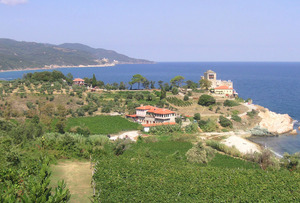 Our trip took us to the most easterly of the three fingers, edging the Gulf of Strymonikos in the Aegean Sea, and into a world of timeless villages, dense forests, perfect beaches, ancient Greek history and religious sanctity.
Our trip took us to the most easterly of the three fingers, edging the Gulf of Strymonikos in the Aegean Sea, and into a world of timeless villages, dense forests, perfect beaches, ancient Greek history and religious sanctity.
Welcome to the Mount Athos area of Halkidiki.
Our 2-day trip was expertly orchestrated by Maria Pappa, the charming and ever-helpful Marketing and Communications Manager of the tourism organisation for this area. We were lucky to be chauffeured throughout the tour by her colleague, another Maria, but a good bus service runs every two hours from Thessaloniki direct to the peninsula.
Arnea
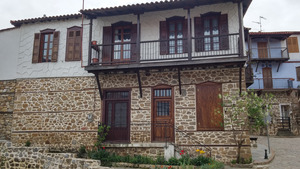 If you’re travelling independently, stop on the way through in Arnea, a small-but-perfectly-formed traditional mountain village, near Mount Cholomontas. Cobbled paths lead away from the enticing square – the focal point for visitors – and up through the attractive Macedonian-style stone houses, often brightly coloured, with wooden balconies and many with black-and-white photos by the door, dated and showing how they looked before meticulous and faithful restoration.
If you’re travelling independently, stop on the way through in Arnea, a small-but-perfectly-formed traditional mountain village, near Mount Cholomontas. Cobbled paths lead away from the enticing square – the focal point for visitors – and up through the attractive Macedonian-style stone houses, often brightly coloured, with wooden balconies and many with black-and-white photos by the door, dated and showing how they looked before meticulous and faithful restoration.
Visit the Museum of History and Folklore for a sense of the community’s timeless traditions, and the Weaving Centre to understand one of their most important activities.
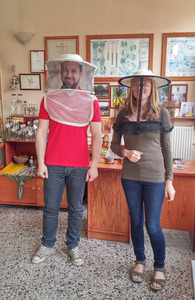 Bee-keeping and local honey production is another. We were given 5 different types of honey to taste, by Argiris Georgakas at his shop Pigi Meliou near the village square. And he presented us with some exquisite beeswax candles, as slim and delicate as fine chopsticks.
Bee-keeping and local honey production is another. We were given 5 different types of honey to taste, by Argiris Georgakas at his shop Pigi Meliou near the village square. And he presented us with some exquisite beeswax candles, as slim and delicate as fine chopsticks.
We were also spoiled by Angelos Gaganis and his daughter Iro at their unpretentious bar, the Cafe Lanara, again near the main square. It may still have been early, but Anglo-Greek relations were much improved by the time we left, after sampling their completely local and organic spoon sweets, fruit liqueurs and fiery tsipouro.
Yet more Greek hospitality came our way a short drive from Arnea, heading into the woody grove of Agia Paraskevi, to the traditional Restaurant Bakatsianos. Owner Dimitrios promised us a special feast for lunch, using traditional recipes and quality local ingredients. He was true to his word.
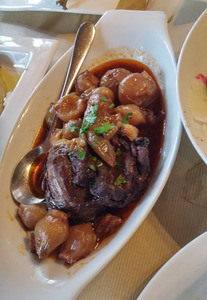 Generous portions of spinach and beetroot salad, with Greek parmesan cheese shavings, aubergine with feta, tomato and olive oil, and potatoes with melted cheese would normally have constituted a substantial lunch for us.
Generous portions of spinach and beetroot salad, with Greek parmesan cheese shavings, aubergine with feta, tomato and olive oil, and potatoes with melted cheese would normally have constituted a substantial lunch for us.
Then the main course arrived.
Vegetarians, look away now.
Plate after plate of meat arrived, each piled almost as high as nearby Mount Cholomontas. Stifado (wild boar roasted with caramelised soft onions), beef fillet with truffles, lamb burgers with cumin and garlic, pork sausages and mustard. All were of an exceptional quality, with a fine local red wine assisting our delicate English digestion.
Pavlova and strawberries were barely necessary, but we couldn’t let our host down. Thanks for a memorable meal, Dimitrios. And for the expanded waistline.
Olympiada
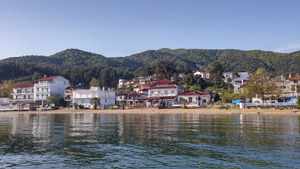 I just about managed to stay awake as we drove east, then slightly north, through green, densely wooded hillsides to Olympiada. Named after the mother of Alexander the Great, this quiet, proud village stands on a wide beach of clean, clear water of the Strymonikos Gulf. 700 metres to the south, the ancient Hellenistic city of Stagira – the birthplace of Aristotle, Greece’s greatest philosopher and tutor of Alexander the Great – stands on a steep, rocky promontory.
I just about managed to stay awake as we drove east, then slightly north, through green, densely wooded hillsides to Olympiada. Named after the mother of Alexander the Great, this quiet, proud village stands on a wide beach of clean, clear water of the Strymonikos Gulf. 700 metres to the south, the ancient Hellenistic city of Stagira – the birthplace of Aristotle, Greece’s greatest philosopher and tutor of Alexander the Great – stands on a steep, rocky promontory.
Now a truly idyllic lotus-eating location, it wasn’t always so.
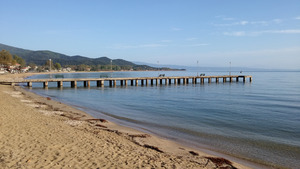 If you decide to travel to Thessaloniki and onward to Halkidiki, try and read Victoria Hislop’s The Thread before you set sail. Early in the book, some of the key characters are a Greek family, violently banished in 1922 from their homes in Asia Minor. A mother and her young daughter are separated while fleeing from Smyrna, and are never reunited, the daughter ultimately living in Thessaloniki with a surrogate family, while her mother and sister end up in a shanty settlement outside Athens. In real life, some of the refugees settled in Olympiada, but it was inaccessible, marshy and plagued with mosquitoes. Many died, or moved to other locations in Greece.
If you decide to travel to Thessaloniki and onward to Halkidiki, try and read Victoria Hislop’s The Thread before you set sail. Early in the book, some of the key characters are a Greek family, violently banished in 1922 from their homes in Asia Minor. A mother and her young daughter are separated while fleeing from Smyrna, and are never reunited, the daughter ultimately living in Thessaloniki with a surrogate family, while her mother and sister end up in a shanty settlement outside Athens. In real life, some of the refugees settled in Olympiada, but it was inaccessible, marshy and plagued with mosquitoes. Many died, or moved to other locations in Greece.
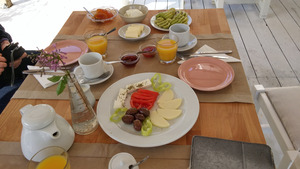 Whilst in Olympiada ourselves, we stayed at the very special Hotel Liotopi. Set back slightly from the beach, at the southern end of the village and close to ancient Stagira, it’s no surprise that it was recently listed by the Guardian as one of the top 10 family hotels in Europe. Boutique-style, intimate and bright, you are engulfed with warmth and hospitality as soon as you walk up the steps.
Whilst in Olympiada ourselves, we stayed at the very special Hotel Liotopi. Set back slightly from the beach, at the southern end of the village and close to ancient Stagira, it’s no surprise that it was recently listed by the Guardian as one of the top 10 family hotels in Europe. Boutique-style, intimate and bright, you are engulfed with warmth and hospitality as soon as you walk up the steps.
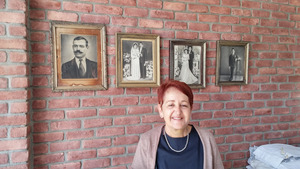 Loulou Alexiadou is the granddaughter of Greek refugees from Asia Minor in 1922. Today her family own the Liotopi and the Hotel Germany in the village, as well as the renowned Akroyali restaurant. They have overcome a challenging history and must be proud of what they’ve achieved here.
Loulou Alexiadou is the granddaughter of Greek refugees from Asia Minor in 1922. Today her family own the Liotopi and the Hotel Germany in the village, as well as the renowned Akroyali restaurant. They have overcome a challenging history and must be proud of what they’ve achieved here.
Loulou’s mother told her to care more for people than for money, and that’s clear every moment you spend at the Liotopi. Welcomed on arrival with fruit liqueurs and freshly baked pastries, we arrived back late at night to find a light, fluffy mince pie-like cake on a small tray on the bed, next to a hand-written card with the message:
Good night – with love – Loulou, Tina, Anastasia
Ancient Stagira
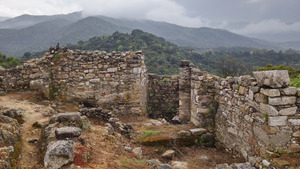 Loulou’s brother Dimitris is an architect, a restaurant and hotel manager, and also a passionate enthusiast for the remarkable walled city of ancient Stagira. Aristotle was born here in 384 BC, but it had been established earlier – in 655 BC – by Ionian settlers, before King Xerxes of Persia occupied it in 480 BC. Dimitris gave us a fascinating tour of the city’s partial excavations, pointing out the original ancient walls with later Byzantine improvements, and bemoaned the lack of funding to complete the rebuilding of history. Silver Travellers beware – much of the old city is built on a steep site, overlooking Olympiada to the north and the Gulf of Ierissos to the south, and a measure of mobility is needed to explore it properly.
Loulou’s brother Dimitris is an architect, a restaurant and hotel manager, and also a passionate enthusiast for the remarkable walled city of ancient Stagira. Aristotle was born here in 384 BC, but it had been established earlier – in 655 BC – by Ionian settlers, before King Xerxes of Persia occupied it in 480 BC. Dimitris gave us a fascinating tour of the city’s partial excavations, pointing out the original ancient walls with later Byzantine improvements, and bemoaned the lack of funding to complete the rebuilding of history. Silver Travellers beware – much of the old city is built on a steep site, overlooking Olympiada to the north and the Gulf of Ierissos to the south, and a measure of mobility is needed to explore it properly.
Walking with Aristotle
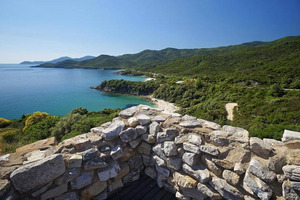 Also for active Silver Travellers, you can walk in the footsteps of Greece’s greatest philosopher. The Aristotelian Walk has been established, from new Stagira, inland in the hills, with the ancient settlement, towering above the sea. Just under 31 kilometres in total, ending at his ancient birthplace, it follows beautiful stony tracks through verdant forests, past waterfalls and amongst the wild herbs and flowers that stimulated Aristotle’s interest in botany and helped him do some of his best Deep Thinking.
Also for active Silver Travellers, you can walk in the footsteps of Greece’s greatest philosopher. The Aristotelian Walk has been established, from new Stagira, inland in the hills, with the ancient settlement, towering above the sea. Just under 31 kilometres in total, ending at his ancient birthplace, it follows beautiful stony tracks through verdant forests, past waterfalls and amongst the wild herbs and flowers that stimulated Aristotle’s interest in botany and helped him do some of his best Deep Thinking.
Varvara
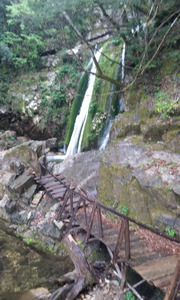 The Varvara waterfall is where Aristotle would stop for extra thinking time. It’s a hidden, contemplative spot that we walked to with Varvara resident Joan Eftimiou and also with a renowned local guide and hunter. Of animals, rather than tourists.
The Varvara waterfall is where Aristotle would stop for extra thinking time. It’s a hidden, contemplative spot that we walked to with Varvara resident Joan Eftimiou and also with a renowned local guide and hunter. Of animals, rather than tourists.
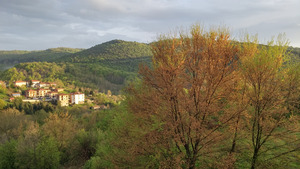 Varvara village is a friendly local community, perched high in the hills above Olympiada, and amongst the forest of Holomontas, thick with beech, oak, alder, wild hazel and linden trees. In the village hall, we met women from the local Agritourist Association ‘Dryades’, named after the female spirits who lived in trees, according to ancient Greek stories.
Varvara village is a friendly local community, perched high in the hills above Olympiada, and amongst the forest of Holomontas, thick with beech, oak, alder, wild hazel and linden trees. In the village hall, we met women from the local Agritourist Association ‘Dryades’, named after the female spirits who lived in trees, according to ancient Greek stories.
Back in 1998, these hard-working and entrepreneurial women decided to promote the beauty and purity of their environment through the Association, using the abundant local ingredients to create healthy, preservative-free sweets, wild fruit jam, liqueurs and traditional local pasta.
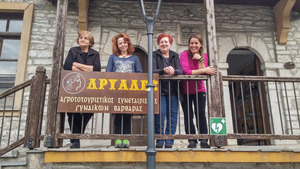 They treated us to a whistle-stop demonstration of making their strawberry jam, before letting us taste a few of the products. The jam, still hot, tasted like nectar from the Greek gods. The liqueurs loosened tongues and the gossip flowed. Another couple of ladies arrived and we had some thick, Greek coffee, the upturned grounds of which foretell your fortune. Apparently, I’m going to be very rich and happy. To paraphrase the immortal words of Meatloaf … 1 out of 2 ain’t bad.
They treated us to a whistle-stop demonstration of making their strawberry jam, before letting us taste a few of the products. The jam, still hot, tasted like nectar from the Greek gods. The liqueurs loosened tongues and the gossip flowed. Another couple of ladies arrived and we had some thick, Greek coffee, the upturned grounds of which foretell your fortune. Apparently, I’m going to be very rich and happy. To paraphrase the immortal words of Meatloaf … 1 out of 2 ain’t bad.
A short drive outside the village, we enjoyed a quiet dinner at the traditional Mygdos restaurant. In a beautiful location, at the foot of Aristotle’s mountain and looking back to the timeless community of Varvara, Stelios and his lovely family served us salads, cheeses and grilled meats, more than filling up the tiny space left after all the other Greek hospitality enjoyed that day.
Ouranoupoli and Mount Athos
The following day we headed south east, around the beach-fringed Gulf of Ierissos towards Ouranoupoli, the gateway to Mount Athos. We stopped in the hills en route to visit the interesting and fun Aristotle Park, and a beautiful Ottoman hammam, used as a sauna and baths for 400 years from the 11th century, and currently being meticulously restored.
Mount Athos – 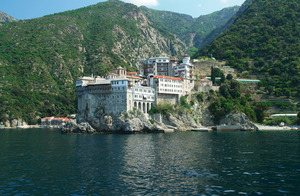 The Holy Mountain – is at the end of the third finger of the Halkidiki peninsula. It could well be the 8th Wonder of the World.
The Holy Mountain – is at the end of the third finger of the Halkidiki peninsula. It could well be the 8th Wonder of the World.
A self-governed monastic state in a place of natural unspoiled beauty, it is inhabited only by monks – more than 2,000 of them – in 20 monasteries of Byzantine architecture, and with 800 cells. Each year almost 1,000,000 people visit this cradle of Greek Orthodoxy. But they are all men.
Access to Mount Athos is religiously controlled. Men can apply for a permit, but there is a meticulous process to follow, and your time and movement within the holy area will be limited.
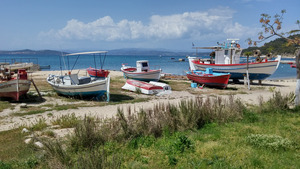 Women can only come within 500 metres of Mount Athos, if on the sea around the monastic peninsula. We had been scheduled to take the boat trip that gives a glimpse of this hallowed place, but sadly the conditions were deemed too windy. Divine irony perhaps, as it was a perfect, sunny spring day back on unsacred land.
Women can only come within 500 metres of Mount Athos, if on the sea around the monastic peninsula. We had been scheduled to take the boat trip that gives a glimpse of this hallowed place, but sadly the conditions were deemed too windy. Divine irony perhaps, as it was a perfect, sunny spring day back on unsacred land.
Our compensation was a gentle stroll around delightful Ouranoupoli, a small village lapping at the edge of the Gulf of Sigitikos, looking west towards the enticing island of Ammouliani. Bars and restaurants, gift shops, art and jewellery galleries were all going through final preparations for the new tourist season. Fishing boats had been pulled up onto the sandy beach. A couple of stray dogs wandered along the shaded promenade.
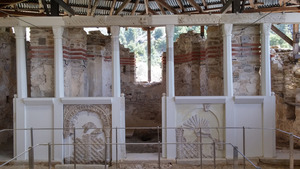 Maria chatted with the owner of Lemoniadis, a waterside restaurant in the village since 1960. We were invited to sit down and enjoy some tsipouro, and of course there’s always food with tsipouro, following Greek tradition. Just a little mezedes, perhaps?
Maria chatted with the owner of Lemoniadis, a waterside restaurant in the village since 1960. We were invited to sit down and enjoy some tsipouro, and of course there’s always food with tsipouro, following Greek tradition. Just a little mezedes, perhaps?
A platter almost the size of Ammouliani arrives, crammed with octopus, anchovies, other local fish, tempura courgettes, tomatoes and much, much more. And then we headed back along the coast a few miles for our scheduled lunch.
Ierissos
Perched high on a hill above the sweeping Gulf of Ierissos, we enjoyed a picnic with the ladies from the local Womens’ Organisation. They arrived from all points of the hillside, bearing plates of homemade dolmades, meatballs, a Greek salad, filo-wrapped savoury dishes, olives, five – yes, five – cheeses, and mussels. Ah, the mussels. They are reckoned to be the best in Greece here – plump, fleshy and naturally fed by plankton, the absence of any rivers flowing into the sea helping to create perfect specimens.
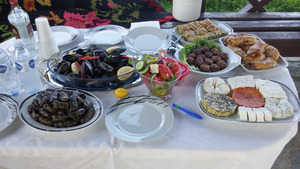 A warm breeze drifted up the hillside from the sea. The clanging bells hung on sheep and goats could be heard but not seen, until the animals crested the ridge and were confronted by a stray dog. The leather-tanned shepherd stopped near the picnic party to fill up his old water bottle from a tap, mounted on a stone surround and inscribed with the date it was built for this humble community. A couple of younger lads – dusty and sweaty from a hard day in the fields – pulled up in a battered truck, and were persuaded to join us for a quick drink and rolled-up cigarettes. One of them had a handshake as vice-like as a metal clamp in the boatyard way below us.
A warm breeze drifted up the hillside from the sea. The clanging bells hung on sheep and goats could be heard but not seen, until the animals crested the ridge and were confronted by a stray dog. The leather-tanned shepherd stopped near the picnic party to fill up his old water bottle from a tap, mounted on a stone surround and inscribed with the date it was built for this humble community. A couple of younger lads – dusty and sweaty from a hard day in the fields – pulled up in a battered truck, and were persuaded to join us for a quick drink and rolled-up cigarettes. One of them had a handshake as vice-like as a metal clamp in the boatyard way below us.
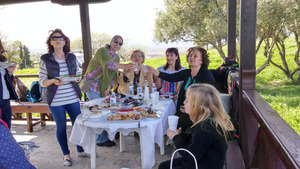 All too soon, it was time to clear up the picnic and say our goodbyes.
All too soon, it was time to clear up the picnic and say our goodbyes.
We headed back towards Thessaloniki, drifting in and out of consciousness and hoping we wouldn’t have to eat anything more until the Greek debt situation has been resolved.
The Mount Athos area of the Halkidiki peninsula is a fascinating and beautiful place to visit, either as an excursion from Thessaloniki or in its own right. It can offer something for all Silver Travellers, whether active or passive, religious or atheist, vegetarian, pescatarian or carnivore, archaeologist or sunbather.
But what I will remember most is its people.
Related articles and reviews:
- Thessaloniki – A Historical and Modern Greek City by Andrew Morris
- Thessaloniki by Jennie Carr
- Thessaloniki: Part 3 – a gastronomic delight by Jacqueline Jeynes
- Thessaloniki: Part 2 – for lovers of the arts, history and culture by Jacqueline Jeynes
- Thessaloniki: Part 1 – a buzzing, lively city worth a visit by Jacqueline Jeynes
- Electra Palace Hotel
- Northern Greece after the summer
- Lake Kerkini, Northern Greece











